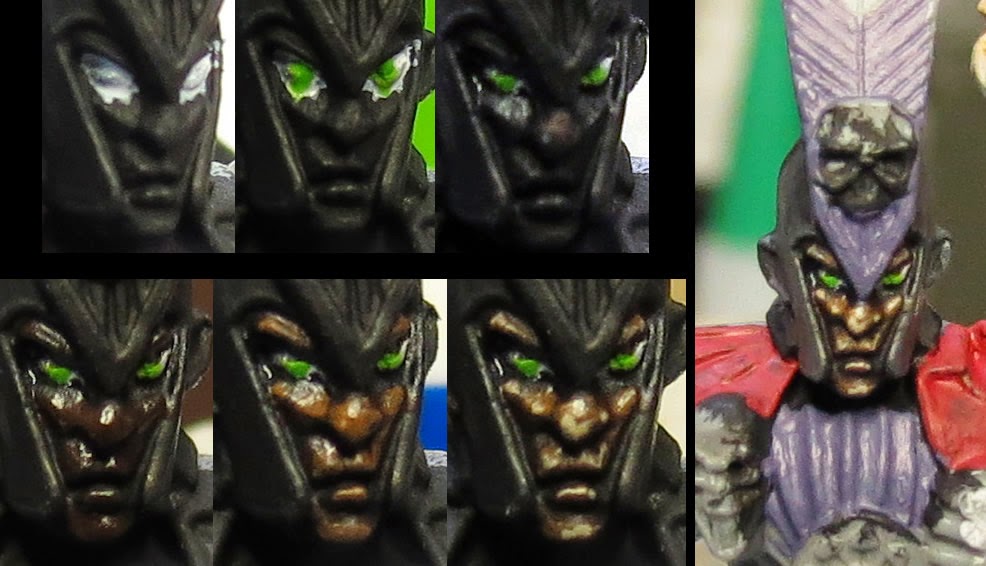Orcs don't have to be green and people don't have to be beige. Within your chosen skin colour, mix it up between darker and lighter versions. Don't be afraid to explore skin tones when painting your army. Even something as simple as using a different base, wash or highlight colour can add some variety.
There are different ways of approaching things like skin, hair, claws, leather pouches, chains, weapons, metals, backpacks, etc. I like to paint "inside out" because I find it easier and you don't end up making as many mistakes or having to touch up as much.
Eyes & Mouth -> Flesh -> Clothes -> Armour -> Trim -> Weapons -> Straps & Rope -> Buckles -> Decoration & Jewelry
For example, if you paint eyes first, when you paint flesh, you can paint the space around them. If you paint the flesh first, eyes become just dots of white painted on top, then you usually have to go back around them with flesh again to clean up the shape. (Sometimes I'll paint eyes last if I want a "feeling" of how the finished model would be looking and just accept it might mean touch ups.)
The Easy Way
 |
| Skin in 3-Steps: Base Wash Highlight |
- White Primer
- It's easier for beginner painters to paint on a White base.
- Choose a Skin Tone
- Most companies have paints with "Flesh" in the title.
- Use a light Beige like Bleached Bone to Khaki to a Medium Brown.
- Light colours can streak, which can show up when you wash.
- Too much paint on your brush will obscure smaller details like facial features.
- Add a small amount of water or thinner if paint's applying thick or streaky.
- Choose a Wash
- Something ranging from Chestnut to a dark Brown.
- Only use Black if the skin is a dark Brown.
- Apply it liberally to the miniature's skin and wait for it to dry.
- (Optional) Highlight
- Use the base skin tone or something similar to paint raised areas.
Painting Light Faces
When painting a face, I prefer to paint the eyes first. Begin with the white of the eyes, then add a pupil with a fine brush.With the same fine brush, paint the skin tone under and above the eye. This creates a safe border and you can paint the rest of the face (with a normal brush) without worrying about ruining the eyes. I've painted some basic colour around the face next for "framing".
Since I chose a skin tone that's not too light, I add a dark brown wash next, followed by a highlight to raised areas like the eyebrows, nose, cheeks, upper lip and chin. (Second picture from the left.) It'd be perfectly acceptable to stop here. Notice I didn't highlight the bottom lip, which gives it the right amount of definition.
To improve the face some more, I use my fine brush again for the following, each step being its own picture, starting with the 3rd from the left: Used brown to strengthen the shadow, used off-white to strengthen the highlight, used elf flesh to make the bottom lip stand out a little more, painted black in to the mouth and finally painted a little dark red in to some of the shadows.
Painting Dark Faces
Don't forget about being and equal opportunity painter.
You can really see here why I paint the eyes first - they can get messy, so once again I paint the face's shade below and above the eyes before continuing.
Darker colours can be trickier and I've used less steps here. A dark brown everywhere but the deepest shadows, and two lighter browns to highlight.
Painting Skin
For this Barbarian, the skin was quick work. I painted a light beige base covered by a chestnut coloured wash. For the 3rd step, I painted a Dry Brush layer over all the skin to lighten it. Finally, I took a darker skin tone to emphasize all shadows.
For this Barbarian, the skin was quick work. I painted a light beige base covered by a chestnut coloured wash. For the 3rd step, I painted a Dry Brush layer over all the skin to lighten it. Finally, I took a darker skin tone to emphasize all shadows.
The face was done much like the other steps. This shows the problem with painting the eyes last, though since dry-brushing is a messy process, was the best choice.
Painted the whites first, then the pupils and mouth. Next I used the darker skin tone to paint under and above the eyes, then a pinkish skin tone on the bottom lip, followed by a little more definition added to the shadows.
Tips
- Add some Gloss Varnish to the eyes before cleaning up around them.
- Painting lips
- Leave the lower lip your base shade or highlight it with a colour other than you use on the rest of the face.
- Only paint the lower lip. Unless the sculpt has a well defined mouth, it'll look clownish if you paint lips around the whole mouth.
- Add a little blush to highlights and shadows.
- Mix a tiny bit of pink to flesh tones and thinly apply it to some raised areas.
- Apply a little red / purple to inset areas like where eyes meet the nose or deeper shadows.





